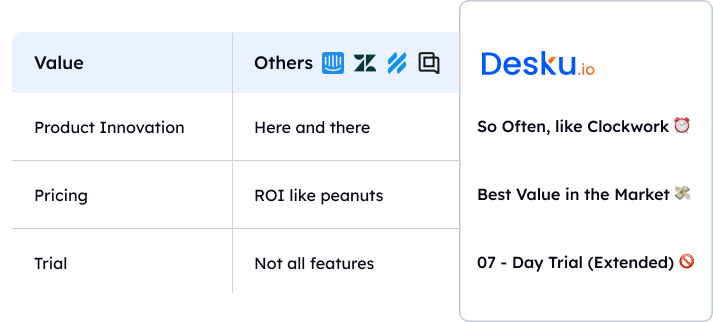Just like you’d use a map to guide you on a journey, you need the right tools and skills to gauge the performance of your customer service teams.
It’s more than just being in charge of a team; it’s about guiding the journey of your company’s customer satisfaction.
This guide will give you the insights needed to effectively and straightforwardly evaluate your customer service team’s performance.
We will discuss essential metrics and the importance of self-reflection.
So, are you all set to enhance your customer service skills?
Key Takeaway :
Evaluating customer service teams is crucial for understanding what’s working and what’s not in your customer service department. It helps you pinpoint areas that might need more attention or training and also lets you give a pat on the back to those who are shining in their roles. By assessing key metrics such as customer satisfaction score, net promoter score, customer retention rate, and average resolution time, you can gain valuable insights into your customer service program’s success and make informed decisions to improve it.
What will you gain from this blog?
Just as you’d rely on a map during a trip, you need the correct tools and abilities to assess your customer service team’s work.
Being a leader isn’t solely about managing a group; it’s also about steering your company’s customer satisfaction journey.
This guide will equip you with the knowledge to assess your customer service team’s efforts straightforwardly and effectively.
We’ll touch on key measurements and the value of self-analysis.
So, are you ready to improve your customer service abilities?
What is Customer Support Evaluation?
How do you measure the success of your customer service team?
Well, this is where customer support evaluation comes into play. It’s like a health check-up for your customer service department, where you measure how well they’re doing in terms of response times, problem-solving skills, customer satisfaction levels, and adherence to company rules and guidelines.
In simple terms, customer service evaluation is your best friend when it comes to understanding what’s working and what’s not in your customer service department. It helps you pinpoint areas that might need a bit more attention or training and also lets you give a pat on the back to those who are shining in their roles.
This evaluation isn’t just a random guessing game, though. It’s backed by data gathered from customer feedback, internal quality checks, performance indicators, and various quality assurance metrics. All these pieces of information come together to paint a pretty accurate picture of the strengths and weaknesses of your customer service team.
What are the Benefits of Evaluating Customer Service Teams?
Checking out how your customer service is doing isn’t just a good thing to do, it’s a must-do for your business. Why, you ask?
Well, it gives you a sneak peek into what your customers need, points out where you can use automation for better efficiency, and shows you a clear picture of your income and expenses.
So, let’s dig a little bit deeper into these benefits, shall we?
1) Detailed insight into your customers’ needs
Think about it this way, if you want to know what your customers need, you have to dig into the nitty-gritty of your customer service operations. It’s like unearthing hidden gems of information about what your customers want. How do you do that? Start with customer satisfaction surveys. They can help you find out exactly what’s bothering your customers, so you can adjust your services and nip problems in the bud.
Getting this deep understanding of your customers is crucial if you want to accurately gauge how well your customer service is performing. It also helps you spot any trends or patterns in how your customers behave. And that’s great for making strategic decisions that hit the mark.
2) Identifies which customer service tasks can be automated
Understanding your customers’ needs and expectations is an important part of customer service. But, let’s not forget about the need for efficiency. This is where automation enters the picture.
Imagine this, your customer service team conducting a detailed analysis to figure out which tasks can be automated. This doesn’t just lead to faster results and lower waiting times, but it also frees up your team to tackle the tougher problems. Automating the routine stuff can save you money and help make the best use of your resources.
In this fast-paced service environment, figuring out what customer service tasks can be automated isn’t just a good idea, it’s a necessity. So, remember to consistently review and update your processes to keep things running smoothly and effectively.
3) Balances your revenue and expenses
Have you ever pondered on the impact of your customer service on your financial performance?
Conducting a thorough analysis of your customer service can shed light on how it affects your revenue and expenses. Believe it or not, top-notch customer service sways 90% of Americans when they’re deciding which company to go with.
So it stands to reason that putting as much effort into your customer service as you do into your marketing or sales can have a big payoff. By evaluating your service, you can pinpoint the areas that need a bit more work, leading to a spike in customer satisfaction. This not only keeps your existing customers coming back for more but also cuts down on churn, which helps to even out your revenue and expenses.
Keep in mind, happy customers are loyal customers, and they’re more likely to spread the good word about your business, which is essential for sustained success and growth. So why not aim to have a customer service team that’s not just average, but outstanding? The effect on your bottom line might surprise you.
4) Lets you calculate the true customer lifetime value
Ever wondered how much every customer is worth to you in the long run? Well, this is where evaluating customer service becomes super handy. It gives you the exact number – we call it the true customer lifetime value.
So why is it so important?
Well, for starters, it gives you a clear picture of who your high-value customers are. This way, you can smartly distribute your resources and make sure the big spenders are getting the attention they deserve.
But it doesn’t stop there.
Knowing the true customer lifetime value also allows you to make well-informed choices about attracting and keeping customers. And yes, that means it can have a direct effect on your customer retention rate.
And there’s more!
It’s also super useful for looking at your customer churn rate – essentially, how many customers you’re losing over a certain period. It’s like having an instant snapshot of how well your customer service is doing.
But the best part?
This metric gives you an in-depth view of how healthy and sustainable your customer base is. It’s like getting a full health check-up for your customer relationships. So, you see, knowing and understanding the true customer lifetime value is an absolute must when evaluating your customer service.
5) Helps to create predictable support quality
Understanding your customer’s lifetime value can bring you to the next major perk of assessing customer service: the ability to establish a stable and consistent standard of support. By taking a good look at your customer service team, you pave the way for a dependable benchmark of support. This, in turn, helps your business consistently deliver excellent customer experiences.
The procedure involves a couple of steps:
- Spotting areas for improvement: By assessing, you can pinpoint where your team might be lagging and take the necessary steps to improve your service quality.
- Keeping high standards: A thorough review of your team’s customer service performance helps in setting and maintaining high standards of service, ensuring your team consistently delivers excellent service.
In a nutshell, assessing the quality of customer service guarantees that your team’s performance aligns with customer expectations, resulting in satisfied and loyal customers.
How to Evaluate Your Customer Service Program’s Success?
If you’re looking to get a handle on how well your customer service program is doing, there are a few crucial numbers you should keep an eye on.
You’ve got your Customer Satisfaction Score (CSAT), which gives you a pretty good idea of how happy your customers are with the service they’re getting.
Then there’s the Net Promoter Score (NPS) – this one is all about whether your customers would recommend you to others.
Other numbers you’ll want to check out include the Customer Retention Rate (CRR), the Net Retention Rate (NRR), and the First Reply Time (FRT).
1) Customer satisfaction score (CSAT)
Your Customer Satisfaction Score, or CSAT for short, is a big deal when it comes to assessing your customer service program’s effectiveness. It’s a no-nonsense metric that tells you straight-up how happy your customers are with the service you’re providing.
Think of CSAT as a compass that guides your customer service team. It’s a number that takes the guesswork out of understanding customer happiness. You’ll usually ask your customers to fill out a quick CSAT survey right after they’ve interacted with your team. This gives you a snapshot of how well you’re doing at that moment.
The great thing about these scores is that they aren’t just cold, hard numbers. They’re a tool for you to use. By keeping tabs on your CSAT, you can see where your service might need a bit of a tune-up.
And here’s the best part – by keeping your eye on this score, you’re actively working to make your customer service even better. You’re not just waiting for problems to crop up, you’re spotting potential issues before they become a big deal. That’s a win for you and a win for your customers!
2) Net promoter score (NPS)
In case you’re curious about how well your customer service operation is going, the Net Promoter Score, or NPS for short, is a handy tool that gives you a pretty good idea of your customers’ feelings and loyalty. It’s a simple approach that involves asking your customers one straightforward question: Would you recommend us to a friend or colleague?
The responses you get are sorted into three groups: promoters, passives, and those not so happy with your service, the detractors. The NPS is then calculated by taking the percentage of promoters and subtracting the percentage of detractors.
Keeping an eye on the NPS regularly is useful for understanding how your customer service is doing. It helps your customer service team see any trends and areas they can work on. It’s a thoughtful way to get some valuable information on how well your customer service operation is performing.
3) Customer retention rate (CRR)
Keeping a close watch on your NPS provides insight into how your customers feel about your brand. But, if you want to know how well your customer service efforts are doing, it’s crucial to look at your customer retention rate (CRR).
Simply put, CRR shows you what percentage of your customers are sticking around.
Here’s the scoop on CRR and customer service:
- A high CRR is great news. It means your customers are happy and loyal.
- On the flip side, a low CRR could be a red flag, indicating your customer service might need a tune-up.
Regularly checking and dissecting your CRR can help you pinpoint where your customer service strategy might need a little TLC. Just keep in mind, that a solid CRR is a big thumbs up for your customer service, and it’s key to helping your business flourish.
4) Net retention rate (NRR)
You can’t ignore the importance of the Net Retention Rate (NRR) when assessing the impact of your customer service program. This critical metric keeps tabs on the revenue changes from your existing customers over a specific time. You can view it as a mirror reflecting how satisfied and loyal your customers are, as well as how effective your customer retention tactics are.
The NRR takes into account things like upgrades, churn, and revenue growth. When the NRR is on the rise, it’s a good sign that your customers are thriving and helping your business to grow. That’s why it’s a good idea to keep a regular check on customer interactions and use this information to fine-tune your service.
5) First reply time (FRT)
Monitoring your First Reply Time, or FRT, is as crucial as keeping an eye on your NRR to gauge customer satisfaction. FRT is a key metric in customer service that helps you understand how promptly your team is responding to customer inquiries or issues.
So, what’s FRT, you ask? Well, it’s essentially the time your team takes to send out that initial response to a customer’s query. The faster your FRT, the more proactive and customer-focused your team appears.
Why should you care about FRT? Well, it can reveal where you’re getting stuck. Plus, a fast FRT positively impacts customer satisfaction and can even sway customer retention. Ultimately, this impacts your team’s overall performance, so it’s something to keep an eye on.
6) First contact resolution (FCR)
Keeping an eye on your First Contact Resolution (FCR) rates is a great way to gauge how well your customer service team is doing. If your FCR rates are high, it means your team is on top of their game, nailing those customer issues right out of the gate. That’s not just good news for your customers, who get their problems solved in a snap, but it’s also a big win for your company’s reputation and customer loyalty.
Monitoring your FCR can give you a real insight into how well your team is performing and point out any areas that might need a bit of a tune-up. An efficient customer service agent doesn’t just deal with customer inquiries, they solve them on the spot.
7) Average resolution time (ART)
Knowing your Average Resolution Time (ART) can shed light on your customer service team’s efficiency in rectifying issues. This metric plays a big role in customer happiness and smooth business operations, so it’s worth keeping an eye on.
When your ART is low, it means:
- Your team is quick on their feet, fixing problems swiftly.
- Customers are likely more content because they’re not waiting around for solutions.
On the other hand, if your ART is high, it could suggest:
- Trouble in paradise: Delays might be a sign of hitches in your service process.
- A need for more training: Your agents might benefit from extra instructions to tackle customer questions more effectively.
8) Total resolution time
When you’re checking out how well your customer service is performing, don’t forget to pay attention to the total resolution time. What’s that, you ask? Well, it’s simply the time that passes from when a customer first reaches out for help to the moment their problem is fully resolved. And why is this so crucial? Because it tells you a lot about how efficient and effective your customer service is.
Think about it. When resolution times are short, it’s a clear sign your team is on the ball – they’re responsive and know their stuff. And that, my friend, leads to happier customers who are more likely to stick with you. But if resolution times are long, there could be a snag somewhere in your support process that you need to fix.
9) Customer effort score (CES)
Think about this – you’re not just assessing the quickness of solving problems when it comes to your customer service program’s performance. It’s also about how easy peasy the customers find their interactions with your service squad. This is where the Customer Effort Score (CES) steps up to the plate.
CES is a big deal in the customer service measurement game. It’s all about measuring the sweat and toil customers put in during their service interactions. If your CES is on the low end, that means your customers are finding it a breeze to sort out their issues – a thumbs-up for your customer service program!
By checking out some real-life customer service situations and using feedback tools, you get to:
- Figure out how to make life easier for your customers, which can lead to them sticking around and feeling more satisfied.
- The spot where you need to step up your game, boosting the success of your program. And don’t forget, the less effort for the customer, the bigger their smile!
10) Conversation abandonment rate
Have you ever thought about the importance of tracking your conversation abandonment rate? It’s a super handy way to check how well your customer service is doing. It’s all about figuring out what percentage of customer chats get left hanging without any resolution. If you notice this rate climbing up, then you might be dealing with sluggish response times or subpar service experiences.
With a keen eye on this rate, you’ll be able to spot where your customer service might be stumbling and take action to fix it. The best part? A decrease in your conversation abandonment rate could lead to happier customers and more of them sticking around. These are some pretty good signs that your customer service is top-tier.
11) Contact rate
Keeping an eye on your conversation drop-off rate is fundamental, right? Well, don’t overlook your contact rate either – it can give you some pretty valuable insights into how well your customer service program is doing.
This essential metric shows you how often your customers are getting in touch with your team, which can give you a good idea of their level of engagement and interaction.
So, how can you make the most of your contact rate? Here are a few suggestions:
- Track how your contact rate changes over time. This can clue you into how alterations in your products, services, or marketing efforts might be affecting customer inquiries.
- If you’re noticing a high contact rate, this might be a red flag. It could mean that some problems are cropping up, or that you need to be a bit more proactive.
- Use the information you gain from monitoring your contact rate to help you fine-tune your customer service KPIs and overall service quality.
12) Backlog
When it comes down to the success of your customer service program, it’s super important to look at the backlog – all those unresolved customer issues that are stacking up. If it’s going up, that’s not a good sign. It could mean you need to step up your game in customer service.
It’s really important to keep an eye on this because it shows how well your service team can handle all the incoming requests. It can even show you how your employees are doing and where things might be getting stuck. If you see lots of unresolved issues and it’s not getting better, you might need to think about how resources are being used.
How to Evaluate Individual Agent Performance in 5 Steps
If you’re looking to measure how well your agents are doing, it’s important not to rush the process. Start by setting the goals for your review. Make sure these targets align with what your company is aiming to achieve.
After this, it’s time to collect and study relevant data. Don’t forget to assess the behaviour and soft skills of your agents, as these are just as important as their technical abilities. Once you’ve gathered all the information, it’s time to sit down with your agents and discuss their performance. Remember to be constructive and helpful in your feedback.
When you’re done, lay out clear expectations for how they should perform moving forward. Now, you’re equipped with a structured plan to better evaluate your agents’ performances.
1) Decide the objective of your review
It’s crucial to pinpoint what you’re aiming to achieve with your review before you start assessing an agent’s performance. Remember, performance reviews aren’t just about highlighting areas that need improvement. They’re also about celebrating wins and monitoring progress.
So, what’s the goal of this review? Do you want to:
- Boost customer satisfaction levels?
- Cut down on response times?
You also need to decide on the performance metrics you’ll use for evaluation. These could be things like:
- How long they typically take to handle a query (average handling time)
- The feedback score from customers (customer satisfaction score)
It’s key to make sure your review objectives align with the broader customer service strategy and business goals. After all, the effectiveness of your customer service is closely tied to your agents’ performance. By setting clear objectives for your review, you’re making sure these assessments actively contribute to your overall success.
2) Analyze relevant data
Navigating through heaps of data can feel daunting, but it’s an important part of measuring how well your customer service team is performing. First, let’s get some tools in your hands to help you understand customer interactions and behaviours better. This information will show you exactly how your team measures up in real-world situations.
Then, let’s check out those crucial customer service KPIs – are customers’ issues being resolved in their first call? How long are customers waiting before they talk to an agent? These bits of data can tell you a lot about how efficient your team is.
But don’t forget about your agents’ product knowledge and their ability to solve problems. These things can make or break a customer’s experience.
And always remember, the goal here isn’t just to get your hands on a bunch of data. The goal is to use that data in a smart way to make your team better and give your customers a great experience every time.
3) Run soft skills and behavioural assessment
Here’s the next part of evaluating how well your customer service agents are doing – we’re going to look at their soft skills and how they behave. This is seriously important because it gives you insight into how well they communicate with people, how they handle conflicts, and how they deal with crises. It’s a pretty good measure of customer service, and here’s how it works:
- You want to see how your agents are talking to customers. Are they clear and friendly? How’s their body language?
- You also want to see how they handle complaints. Can they smooth things over quickly and effectively?
But don’t just stop at those points. You also want to look at how your team behaves:
- How good are they at solving problems? Do they think outside the box? Are they proactive?
- How do they handle customers? Are they empathetic and patient? Can they adapt to different situations?
Make sure you do these assessments regularly. It’s a great way for your team to learn and get better.
4) Present your findings to the agent
So, you’ve done all the hard work of evaluating your customer service agent’s performance, and now it’s time to share what you’ve found out. It’s all about making sure they get the complete picture of how they’re doing. So, let’s talk about this strategically, but keep it easy to understand.
First up, let’s chat about their First Call Resolution and Customer Waiting Time. These are pretty big parts of any customer interaction, so it’s good to see how they’re doing here.
Then, we can move on to their Customer Greeting and Product/Service Knowledge. It’s always good to know what they’re doing well, but also where they could do a bit better.
Last but not least, we’ll get into their problem-solving skills. We want to focus on how well they can meet the needs of our customers because that’s what it’s all about, right?
5) Set goals and expectations
Setting tangible goals and laying out clear expectations are vital when it comes to maintaining a high standard of customer service. This way, you can make sure your team is always on the same page and working towards the same objectives. This kind of strategic planning can make it a breeze to assess your customer service team and reps, leading to the happy result of meeting or even surpassing customer expectations.
Here’s what you should concentrate on:
- Setting Goals: Your customer service goals should reflect your larger company objectives. These goals could be anything from boosting customer satisfaction rates to cutting down on response times. Just remember:
- They need to be quantifiable: Each goal should come with specific metrics.
- They need to be reachable: Goals should be ambitious, but not out of your team’s grasp.
- Setting Expectations: Be crystal clear about what you expect in terms of performance and behaviour. This might include:
- Sticking to the company’s customer service policies.
- Providing consistently high-quality service during all customer interactions.
Don’t forget to regularly go over these goals and expectations with your team. Make sure they have the necessary support and resources to meet these objectives. After all, a team that knows where they’re heading not only hits their targets but also makes a significant contribution to the overall success of your business.
What are signs that tell your customer service program needs a makeover?
Here are the four key signs that your customer service needs an update, rewritten simply and engagingly for better understanding:
- Too Many People Asking for Help (Over 33% Contact Rate): If more than one in three customers needs to ask for help, something’s not right. Maybe your website’s hard to use, or it’s tough to find info about your orders. To fix this, add ways for customers to help themselves, like a FAQ section or a chatbot that can answer common questions.
- Customers Aren’t Super Happy (CSAT Below 4/5): If customers aren’t giving you at least 4 out of 5 stars, it’s a sign they’re not too happy. This could be because it’s hard for them to get the help they need or they’re not satisfied with the answers. Improve this by training your team better and always asking customers how you can do better.
- Slow to Reply and Solve Problems: If it takes a long time to get back to customers or solve their problems, they’re going to get frustrated. Customers expect quick answers, so if it’s taking days, that’s a problem. Get quicker by adding more self-help options and setting up auto-replies to let them know you’re on it.
- Spending Too Much on Support: If you’re spending a lot of your money on customer service, it might mean your team isn’t working as efficiently as they could be. Check to see if your team is dealing with too many tickets or taking too long to solve them. To get better, figure out a good plan for how many tickets each person should handle and train everyone to stick to it.
By looking out for these signs and taking action to improve, you can make sure your customer service is helping your business grow instead of holding it back.
Develop happy customers and happier business with Desku
By now, you are quite aware of the importance of customer service evaluation and almost all the top tactics to evaluate customer service teams, it is now the right time to avail yourself of the best helpdesk support platform -Desku.
Desku.io is one of the most affordable helpdesk customer support platforms that help bring team collaboration into one place with its features like easy assigning of customer agents to relevant tickets to solve them precisely and much more.
The perfect conversation with customers is always remembered by them as it is part of the customer experience, the quality of how you serve your customers and how they are treated is one of the most important activities that helps in recurring purchases from your business.
Waiting for what? Take Desku trial today, elevate your customer support agent’s work by bringing efficiency in providing support.













